LIFE (September 20, 1943)
The Midwest’s mood
Its farmers are making top money, cursing Washington and hating labor
By Eliot Janeway
…
LIFE (September 20, 1943)
Its farmers are making top money, cursing Washington and hating labor
By Eliot Janeway
…
…Library of Congress unearths first newsreels
Newsreels today are doing a fine job of covering the war. Newsreel cameramen travel with troops in the jungles of New Guinea, in planes on bombing missions over Berlin, with naval task forces in enemy waters. But in the past, newsreels have seldom been a serious record of current history. Too often they have chosen to regard six-day bicycle races, flagpole sitters and bathing-beauty contests as the most important things in the contemporary scene. One exception to this has been the infancy of the newsreel, when it had not yet occurred to anyone that they should show anything but real news. The pictures shown here, from the Library of Congress’ newfound collection of old films, are a surprisingly complete coverage of the news events of their day.
Outside of the Library of Congress, few early newsreels have been perfectly preserved. Most have been used until they were worn beyond recall. Others were lost when they decomposed chemically because of primitive processing and storing. Even the Library’s collection has been preserved almost by accident. Before 1912, all motion pictures had to be copyrighted as still photographs on long strips of photographic paper which lasts better than celluloid film. Recently the Library uncovered in one of its vaults a hoard of 2,500,000 feet of this old paper film, a priceless history of the motion-picture industry from 1897 to 1912.

This 1898 Edison newsreel shows Colón, Cuba, funeral procession of victims in the sinking of battleship USS Maine.
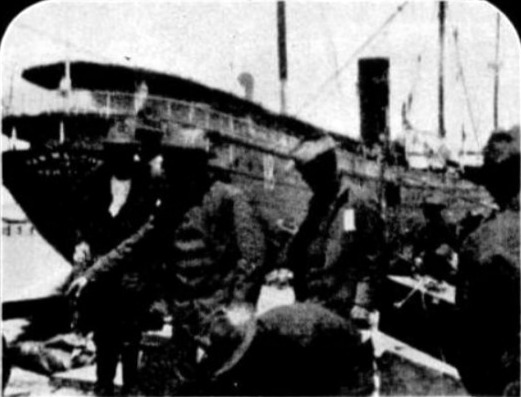
Also in 1898, the Edison Company filmed the embarkation of Theodore Roosevelt’s famous Rough Riders for Santiago, Cuba.
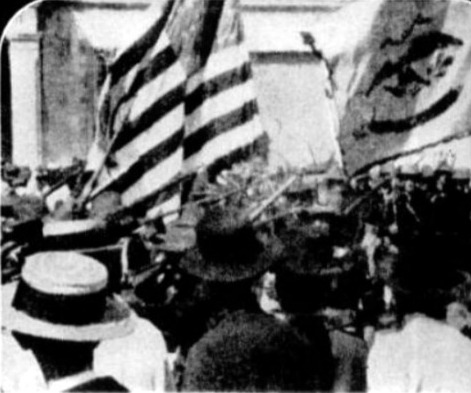
In 1899, American troops left Havana. The Spanish-American War was the first to be covered by newsreel cameras.
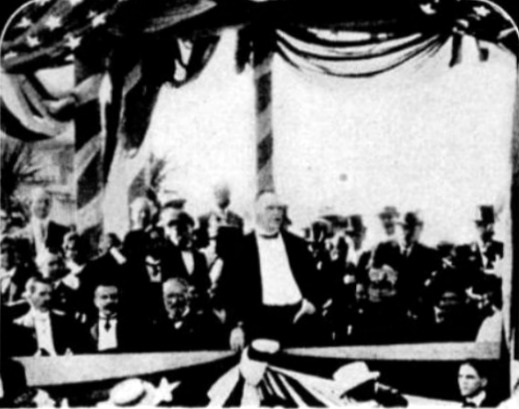
The newsreel of McKinley’s address at the Pan-American Exposition (1901) was made just before he was assassinated.
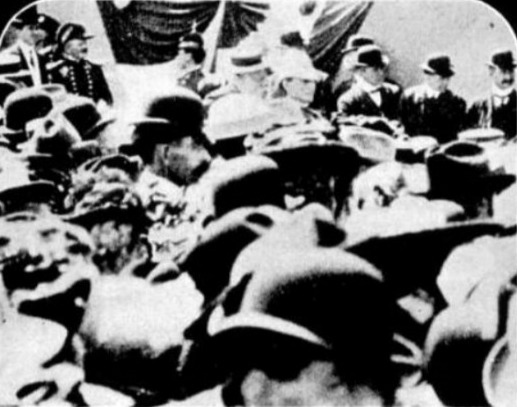
Crowds mill about entrance of Exposition’s Temple of Music after McKinley had been shot by assassin Leon Czolgosz.
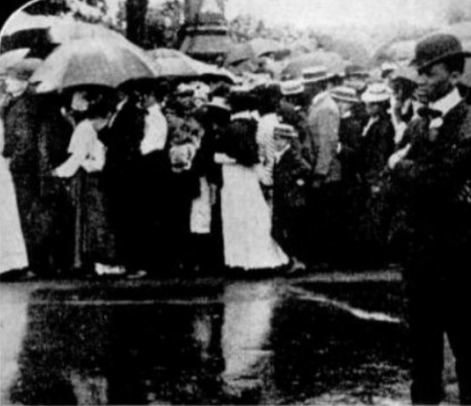
McKinley’s body was brought from Buffalo to Washington. Crowds waited in the rain to see him lying in state.
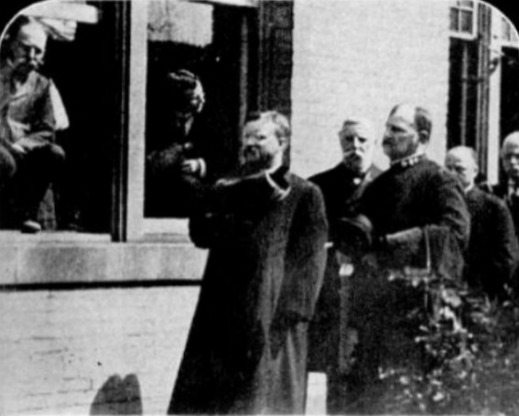
Theodore Roosevelt, McKinley’s Vice President and successor, met the funeral train in Canton, Ohio, McKinley’s home.
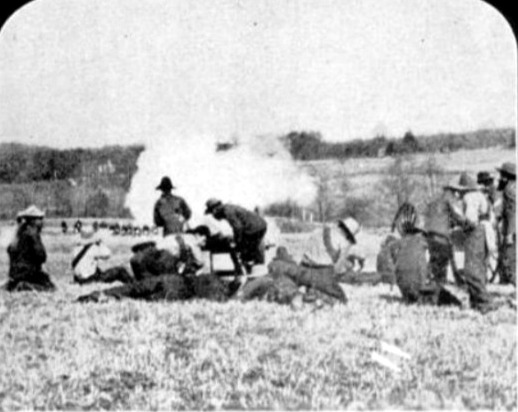
This battle scene from the Boer War (1900) was called authentic, but early newsreels were not above reenacting big events.
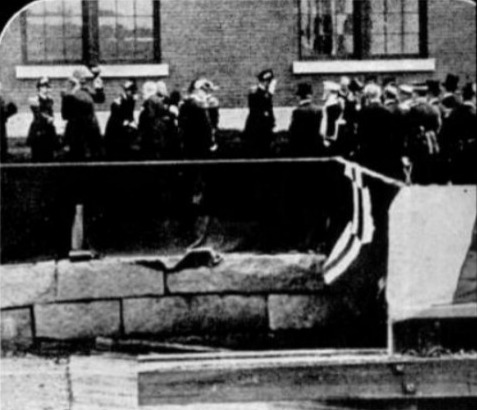
U.S. Adm. Mead greets envoys at the Russo-Japanese Peace Conference in Portsmouth, New Hampshire, in 1905.
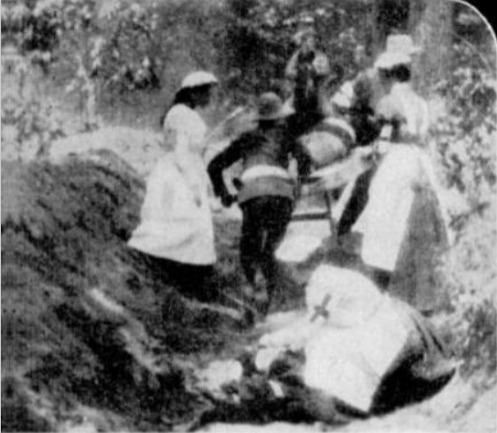
In 1899, Edison reenacted the scene of U.S. nurses and wounded near Manila, during the Spanish-American War.
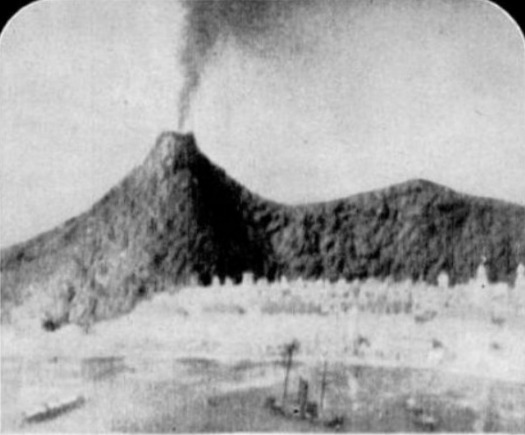
Another Edison reenactment simulated the disastrous eruption of Mt. Pelée in 1902. Note the model ships in the fake harbor.
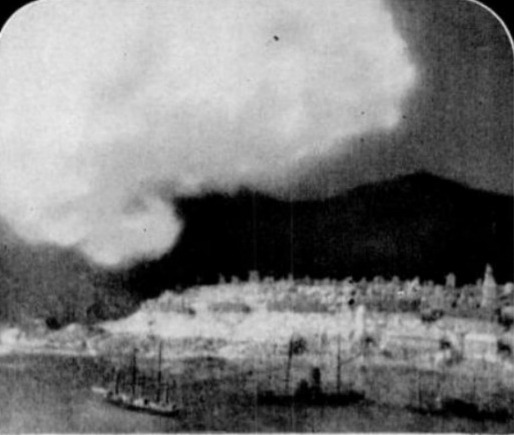
Model of Mt. Pelée smokes realistically. The eruption wiped out the thriving Martinique city of St. Pierre, killing 40,000.
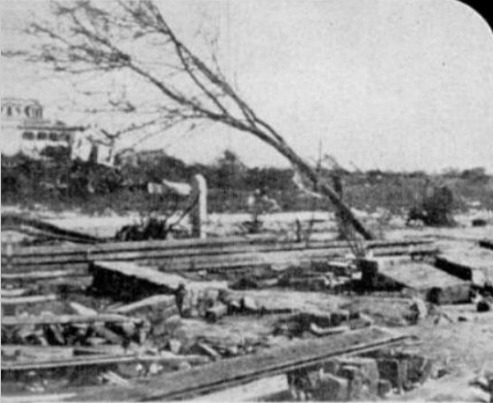
The American disaster covered by newsreel was the 1900 hurricane which struck Galveston, Texas, causing great damage.
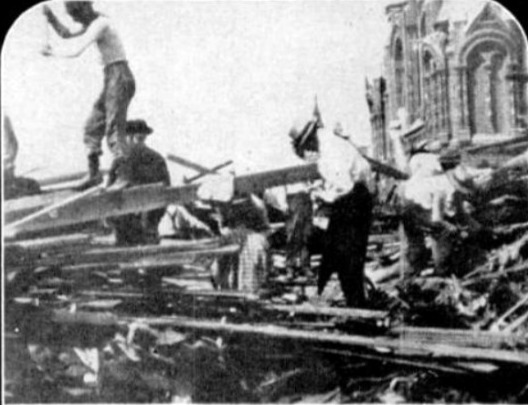
Workmen dig for bodies of the hurricane victims. Most damage was caused by giant waves which came with the wind.
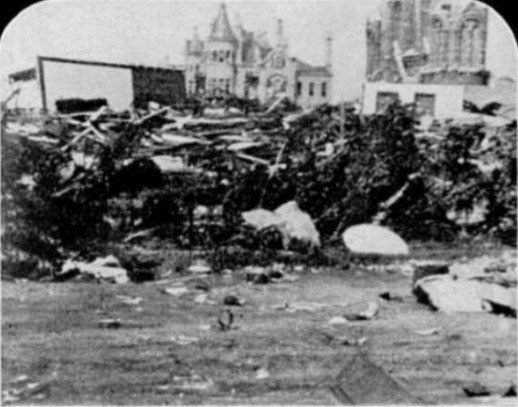
Wreckage of Galveston. The city was almost completely destroyed, but a more solidly-built new one rose in its place.
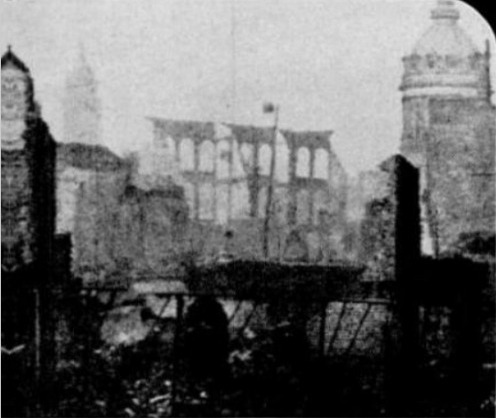
The Baltimore fire of 1904 was another great disaster which hit an American city in the early part of the century.
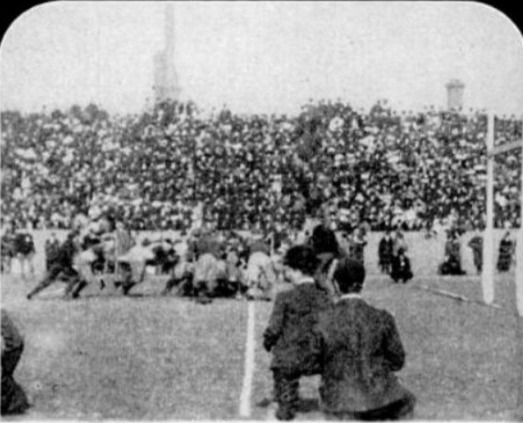
Harvard-Pennsylvania football game, the forerunner of present-day fall newsreels, was photographed by Edison in 1903.
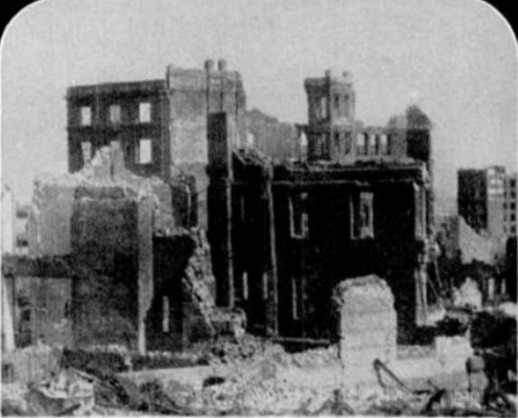
The ruins of San Francisco after the 1906 earthquake and fire was covered by Biograph, another pioneer movie company.
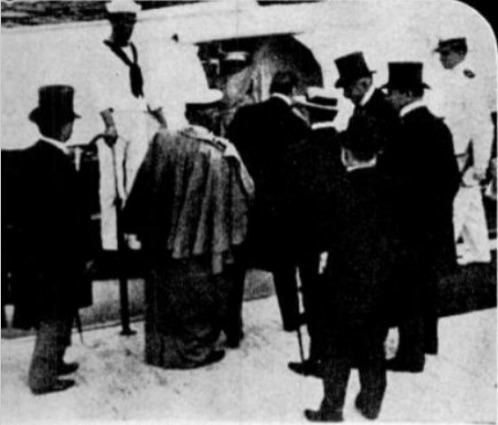
Top hats and gold braid get into gig in another scene of the Portsmouth Conference. Peace took over a month to settle.
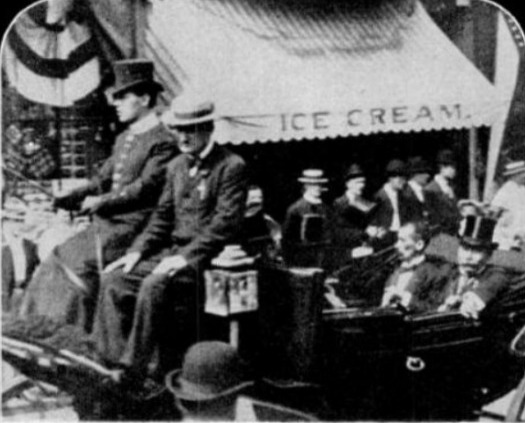
Japanese envoys on their way to discussions at the Portsmouth Court House. The conference was arranged at Roosevelt’s invitation.
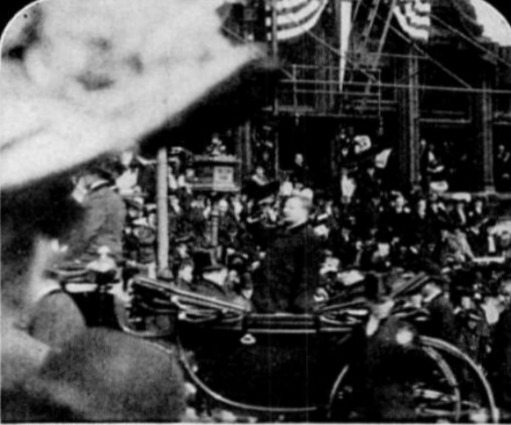
Roosevelt waves his hat from his carriage on the way down Washington’s Pennsylvania Ave. to his inauguration in 1905.
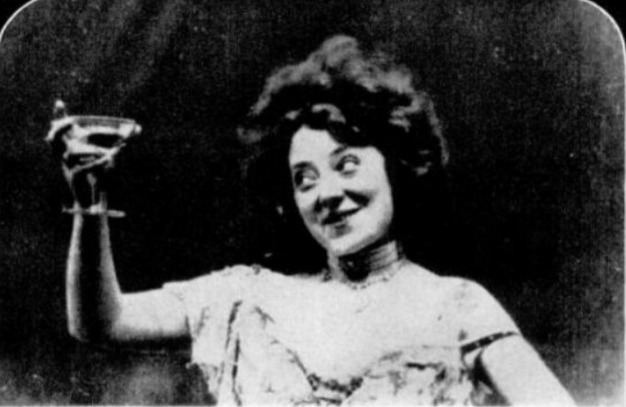
Staged productions also appear in the Library of Congress film collection. Anna Held made this scene from the play Papa’s Wife from Biograph in 1902.
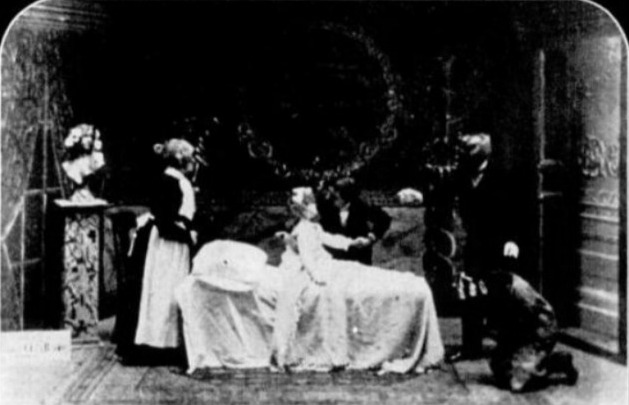
Uncle Tom’s Cabin, the first of many productions, was made in 1903 by Edison. This is scene ay Eva’s deathbed, with Tom and Topsy at right.
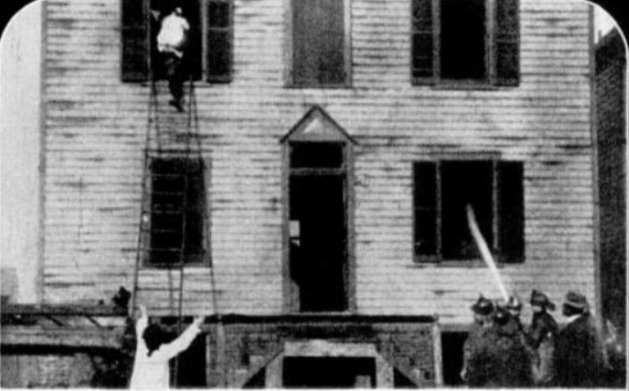
First film to carry a narrative through a number of different sets and scenes was The Life of an American Fireman, made by Edison in 1903.
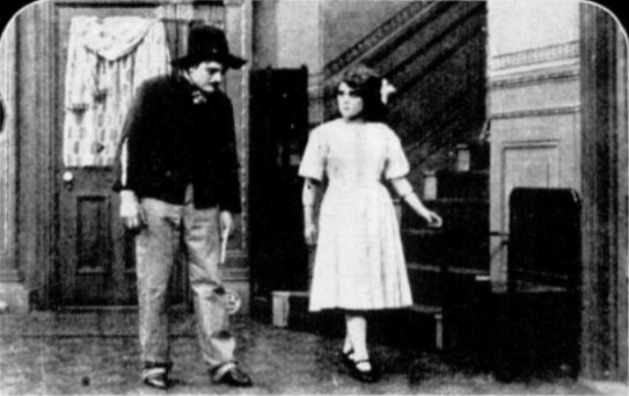
Mary Pickford’s first picture, The Lonely Villa, was made for Biograph in 1909. “America’s Sweetheart” was only 16 years old at the time.
Where these boys fell, a part of freedom fell: We must resurrect it in their name
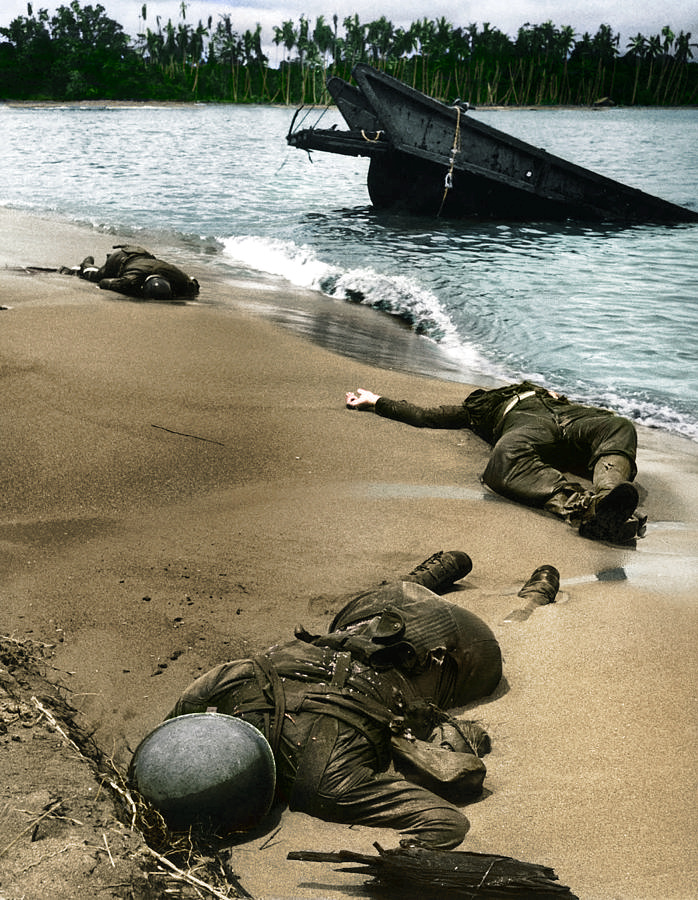
Three dead Americans on the beach at Buna. (Photo by George Strock)
Here lie three Americans.
What shall we say of them? Shall we say that this is a noble sight? Shall we say that this is a fine thing, that they should give their lives for their country?
Or shall we say that this is too horrible to look at?
Why print this picture, anyway, of three American boys dead upon an alien shore? Is it to hurt people? To be morbid?
Those are not the reasons.
The reason is that words are never enough. The eye sees. The mind knows. The heart feels. But the words do not exist to make us see, or know, or feel what it is like, what actually happens. The words are never right.
Last winter, in the issue of Feb. 22, we told about Bill, the Wisconsin boy; how he struggled through the dark and nervous jungle of New Guinea, stalking Japs like a cat; how he came at last to the blue sea at the rim of the jungle, and ran out onto the white beach, blazing mad; how the Japs got him there, suddenly, when the job was almost finished, so that he fell down on the sand, with his legs drawn up; and how the tide came in…
And we said then that we thought we ought to be permitted to show a picture of Bill – not just the words, but the real thing. We said that if Bill had the guts to take it, then we ought to have the guts to look at it.
Well, this is the picture.
And the reason we print it now is that, last week, President Roosevelt and Elmer Davis and the War Department decided that the American people ought to be able to see their own boys as they fall in battle; to come directly and without words into the presence of their own dead.
And so here it is. This is the reality that lies behind the names that come to rest at last on monuments in the leafy squares of busy American towns.
We come late
Here in this picture, we meet upon a battlefield of the war.
It is true that we come late to the battlefield – much later than these boys, who were the first to arrive. The tide has already covered them at least once. The sand has almost buried the leg of one of them, and you can see the dark marking of high water on his helmet.
Even so, we are not too late to understand this battlefield. We can see roughly what happened.
They were shipped to Australia in 1942, thence to Port Moresby, New Guinea, thence by airplane over the Owen Stanley Mountains. They were set down in the heart of the jungle. Their objective was Buna.
They struggled through the nightmare – week after week of Japs lurking in trees and jungle pillboxes, week after week of foxholes and bugs and skin sores and sleepless nights. Then at last Sgt. Bottcher, with a dozen men, broke through to the sea. Bottcher’s Corner, where he held out for days, lies just beyond the coconut palms in the background of this picture.
And meanwhile the Japs had been trying to bring up reinforcements in landing barges. Many barges were wrecked on the shore by American airmen, just as the one shown here. But when the Jap soldiers were finally driven back to the sea, hey hid in these half-sunken barges. And they also constructed hidden machine-gun nests all along the shore.
So, when these three boys broke out of the jungle, they ran down to the beach, chasing Japs in a kind of fury. They were running in from the left and they had just passed the barge. And then, there was a sudden, murderous burst of fire – apparently not from the barge, but from a machine-gun nest located in the direction of where you, the reader, are sitting. The boy in front was riddled. The one in the center, who was apparently blasted over backward and has been rolled by the waves, was hit above his left hip; a bullet went into his left leg and his right leg was shattered. The third has fallen forward as if clutching a wound in his abdomen. It all must have happened in a split second.
Yes, when LIFE’s photographer, George Strock, arrived with his camera to take this picture, it was all over. And yet, miraculously, it is not too late; miraculously the battle still goes on, and we can still see, in every line of action, why it is that American boys win.
We can still sense the high optimism of men who have never known oppression – who, however scared, have never had to base their decisions upon fear. We are still aware of the relaxed self-confidence with which the leading boy ran into the sudden burst of fire – almost like a halfback carrying the ball down a football field.
We can share their impatience, their outrage at the evil of war. We can feel the fury of their attack, the hard muscles driving forward, the hot blood surging. Yes, we can tell even on this distant shore that these are our boys, born of our women, reared in our schools, bred to our horizons…
Even though the tide has come in at least once to cover them…
Something on the beach
And it is not enough to say that words are not enough. There is something lying on this beach that the camera doesn’t show.
It doesn’t show a green meadow stretching down from a whitewashed barn to the brook that bubbles through an American valley. And it doesn’t show an elderly man climbing up a ladder in a ripe American orchard; or a stout, gray-haired woman pulling out of the oven an American apple pie; or a red setter asleep on the sunny porch dreaming of American birds.
The camera doesn’t show a road leading around the wood lot under the big harvest moon. It doesn’t reproduce the sound of a girl’s voice when she told him, or the feel of her waist, or the memory of her promise.
And it doesn’t show the pool hall where the boys get the baseball scores, or the Congressman leaning back in his law office with his hands behind his head, or the banker scrutinizing old Sam Lawrence, or the minister in his pulpit pointing upward to where he thinks God is.
No, the camera doesn’t show America, not any part of America, not even her mighty hills and rivers, not even the great gray cities or the freight trains tramping through the night loaded with the paraphernalia of war. Out there at Buna it couldn’t show any of that.
And yet here on the beach is America, three parts of 130 million parts, three fragments of that life we call American life; three units of freedom.
So that it is not just these boys who have fallen here, it is freedom that has fallen; the smell, the taste, the sound, the sight of freedom, the desire, the realization, the manifold, intoxicating experience that freedom is. All this has fallen upon the white New Guinea sand.
And freedom lives
America is the symbol of freedom.
It is the symbol, not only here at Buna, and not only at Guadalcanal, where the crosses crowd the shore; and not only in half-starved Sicily, and not only in trembling Rome;
It is the symbol of freedom all over the earth, wherever men dream of freedom, or desire it;
In the bright green hills of China, and under the old roofs of Prague, and in the teeming alleys of Cairo, and along the jagged Scandinavian shore.
And all over the world, now, there are living fragments of this symbol, and all over the world they are being shot down, like these fragments.
And it is not an easy thing to understand why they are there, and why, if freedom is to live, they must be willing to die.
But this is because freedom is something more than a set of rules, or a set of principles. Freedom is a free man. It is a package. But it is God’s package.
So, when these living units of freedom are extinguished, we cannot bring them back to life. All we can do is to give meaning to their death.
And this is to say that when freedom falls, as it has here on the beach at Buna, it is our task to cause it to rise again; not in living units, which we cannot make and to which we cannot give life, but in the mighty symbol, America, the beacon for all men, which is ours to have, to hold, and to increase.
The Pittsburgh Press (September 20, 1943)
Enemy flees to Corsica where French patriots seize port
By Donald Coe, United Press staff writer
…
Nazis retreating toward Naples; Yanks seize heights on gulf
By Richard D. McMillan, United Press staff writer
…
Premier urges ‘terrible guerrilla warfare’
…
Navy serves notice on Axis of vast power
By Sandor S. Klein, United Press staff writer
…
Land army ready now to join battle, Congress told
…
Eisenhower and Somervell are both mentioned for post
By Lyle C. Wilson, United Press staff writer
…
New London, Connecticut –
The submarine USS Gabilan was launched yesterday at the Electric Boat Company, Groton.
Los Angeles, California –
Lt. Col. James Roosevelt of the Marine Corps was on his way east today to see his father, President Roosevelt, for the first time in 18 months. Col. Roosevelt, fresh from the Aleutians, boarded an American Airlines plane yesterday and said he planned to return here Thursday.
U.S. 14th Air Force HQ, China – (Sept. 19, delayed)
Mitchell bombers heavily damaged a Japanese-operated foundry and ore-smelting plant southeast of Hankow yesterday, scoring direct hits on warehouses and three furnaces. The raiders were led by Capt. Don Milan of Ruston, Louisiana. All the planes returned safely.
Londonderry, Northern Ireland –
U.S. Secretary of the Navy Frank Knox yesterday inspected the American naval base here and lunched with the Duke of Abercorn, Governor of Northern Ireland, and then left for Scotland, the home of his ancestors.